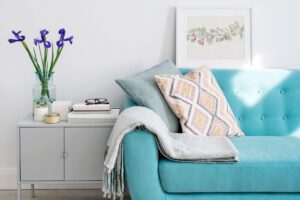How to Design a Calm Corner: Creating a Relaxing Space at Home

In the chaos of daily life, your home should be more than just a place to sleep—it should be a sanctuary. But with work deadlines, endless notifications, and city noise, finding a moment of peace can feel impossible. Enter the calm corner: a personal retreat designed to help you unwind, recharge, and boost mental well-being. Whether you’re a busy professional in Hong Kong or a remote worker juggling meetings, creating a relaxation space at home is essential for mental health and productivity.
Why You Need a Calm Corner
Research shows that dedicated relaxation spaces can significantly reduce stress and improve focus. A home sanctuary allows you to step away from work stress, recharge, and return with renewed energy. From boosting mindfulness to enhancing sleep quality, the benefits are undeniable.

Essential Elements for a Peaceful Home Sanctuary
Creating a serene space doesn’t require a major renovation. A few key elements can transform any corner of your home into a tranquil escape:
✅ Comfortable Seating – A plush armchair, floor cushions, or even a hammock to encourage relaxation.
✅ Soothing Colors – Soft blues, muted greens, and neutral tones are best for reducing stress.
✅ Natural Elements – Incorporating plants and wooden furniture can create a grounding atmosphere.
✅ Soft Lighting – Warm, dimmable lights or fairy lights enhance coziness.
✅ Minimal Distractions – Keep the space clutter-free to maintain a sense of calm.
Designing a Meditation or Mindfulness Corner
A mindfulness space doesn’t require much—just a few intentional choices:
- Pick a quiet area: Choose a space away from high-traffic zones.
- Add a comfortable mat or cushion: Ideal for meditation or deep breathing exercises.
- Use soundproofing techniques: A white noise machine or thick curtains can help block out distractions.
- Incorporate aromatherapy: Essential oils like lavender and chamomile can enhance relaxation
Creating a Cozy Reading Nook
Love unwinding with a book? Here’s how to design the perfect reading retreat:
- Choose a corner with good natural light.
- Use a comfy chair or bean bag for lounging.
- Add a side table for books, tea, or candles.
- Use soft textiles like blankets and throw pillows to enhance comfort.
Best Colors for a Calming Home Environment
Color psychology plays a huge role in relaxation. According to design experts:
- Soft blues promote tranquility and reduce anxiety.
- Muted greens create a connection to nature and foster calmness.
- Neutral tones like beige and off-white provide a clean, stress-free ambiance.
| Color | Effect on Mood |
| Soft Blue | Reduces stress, promotes calmness |
| Muted Green | Enhances focus, connects to nature |
| Neutral Tones | Creates a clean and peaceful vibe |
DIY Projects for a Personal Touch
Want to personalize your relaxation space? Try these simple DIY projects:
- Hand-painted wall art with calming quotes.
- DIY essential oil candles for aromatherapy.
- Macramé wall hangings for a boho-chic aesthetic.
- A mini water fountain for soothing background sounds.
How a Calm Corner Boosts Productivity
Surprisingly, having a dedicated relaxation space can make you more productive. A study by the Draugiem Group found that employees who took short breaks in a relaxing environment were more focused and efficient. Whether you use your calm corner for quick meditations, journaling, or deep breathing, it can help reset your mind and improve your work performance.
Final Thoughts: Make Wellness a Priority
In a fast-paced world, having a calm corner at home isn’t a luxury—it’s a necessity. A personal retreat helps you de-stress, recharge, and maintain mental clarity. Ready to enhance your well-being? Book a demo with Mixcare to explore customizable employee benefits that make work-life balance effortless.
